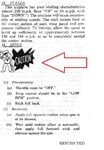How can stall characteristics be good if there is no stall warning? Seems like if this is as critical as you say, then the stall characteristics should have been labeled "deadly" or "catastrophically bad" or something along those lines.
And an aircrafts characteristics regarding the warning leading up to the stall are part of whether it has good or poor stall characteristics. An aircraft that gives you no warning at all is not really ideal.
For "everyday Joes" like us, Adler's got it right, but in the rarefied world of aerodynamicists and test pilots (who write performance reports, BTW), it's more like Koopernic says, incipient stall warning and behavior in the stall are two separate topics, to be explored and reported separately.Test pilots often refer to characteristics such as 'stall annunciation' and departure characteristics.
PS: Any test pilot worth his salt is going to be a very precise flyer who's going to fly through every stall with perfect aileron-rudder coordination, thus not provoking the beast to display its nasties. It's what they do. If he happens to do a "sloppy" stall entry and experiences unpleasantness, and his boss is trying to sell airplanes, or trying to justify buying them, do you think he's likely to make an official big deal over it? Not if he wants to keep his job, and in the case of a civilian, his draft deferment. The infantry is always insatiable for bodies. He'll probably settle for planting a bug in the ears of the folks in the test and development shop.
Last edited:


